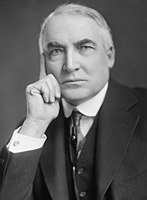| ||||||||||||||||||||||||||
All 12 Tennessee votes to the Electoral College | ||||||||||||||||||||||||||
|---|---|---|---|---|---|---|---|---|---|---|---|---|---|---|---|---|---|---|---|---|---|---|---|---|---|---|
| ||||||||||||||||||||||||||
 County results
| ||||||||||||||||||||||||||
| ||||||||||||||||||||||||||
| Elections in Tennessee |
|---|
 |
|
|
The 1920 United States presidential election in Tennessee took place on November 2, 1920, as part of the 1920 United States presidential election. Tennessee voters chose 12 representatives, or electors, to the Electoral College, who voted for president and vice president.
For over a century after the Civil War, Tennessee was divided according to political loyalties established in that war. Unionist regions covering almost all of East Tennessee, Kentucky Pennyroyal-allied Macon County, and the five West Tennessee Highland Rim counties of Carroll, Henderson, McNairy, Hardin and Wayne[1] voted Republican – generally by landslide margins – as they saw the Democratic Party as the “war party” who had forced them into a war they did not wish to fight.[2] On the other hand, the rest of Middle and West Tennessee, which had supported and driven the state’s secession, was equally fiercely Democratic because it associated the Republicans with Reconstruction.[3]
After the disenfranchisement of the state’s African-American population by a poll tax was largely complete by the 1890s,[4] the Democratic Party was certain of winning statewide elections if united,[5] although, unlike the Deep South Republicans, the Democratic Party would almost always gain thirty to forty percent of the statewide vote from mountain and Highland Rim support. The Republicans did win the governorship in 1910 and 1912, when the Democratic Party was bitterly divided, but did not gain at other levels of government.
During the period before the 1920 presidential election, Tennessee was the center of bitter debate over the ratification of the Nineteenth Amendment, which the state, with its Democratic Party still seriously divided,[6] ultimately passed by a very close margin, 50 to 46, in the House of Representatives.[7]
Although most Republicans in the state legislature had supported the Nineteenth Amendment,[7] outgoing Democratic President Woodrow Wilson’s League of Nations was deeply unpopular in the isolationist and fundamentalist[8] Appalachian regions,[9] and the President was thus stigmatized for his advocacy of that organization. Democratic nominee James M. Cox also supported American participation in the League,[10] whereas his rival Warren Harding was largely opposed to the League and was helped in the South by racial and labor unrest elsewhere in the country.[11]
- ^ Wright, John K. (October 1932). "Voting Habits in the United States: A Note on Two Maps". Geographical Review. 22 (4): 666–672. Bibcode:1932GeoRv..22..666W. doi:10.2307/208821. JSTOR 208821.
- ^ Key (Jr.), Valdimer Orlando (1949). Southern Politics in State and Nation. New York City. pp. 282–283.
{{cite book}}: CS1 maint: location missing publisher (link) - ^ Lyons, William; Scheb (II), John M.; Stair, Billy (September 17, 2023). Government and Politics in Tennessee. Univ. of Tennessee Press. pp. 183–184. ISBN 978-1572331419.
- ^ Phillips, Kevin P.; The Emerging Republican Majority, pp. 208, 210 ISBN 9780691163246
- ^ Grantham, Dewey W. (Fall 1995). "Tennessee and Twentieth-Century American Politics". Tennessee Historical Quarterly. 54 (3): 210–229.
- ^ Marcellus, Jane (Summer 2010). "Southern Myths and the Nineteenth Amendment: The Participation of Nashville Newspaper Publishers in the Final State's Ratification". Journalism and Mass Communication Quarterly. 87 (2): 241–262. doi:10.1177/107769901008700202. S2CID 145009700.
- ^ a b "Woman Suffrage Wins as Tennessee Ratifies: Close Vote of 50 to 46 in House May Still Be Upset Upon Reconsideration". Boston Daily Globe. August 19, 1920. p. 1.
- ^ Ruotsila, Markku (2003). "Conservative American Protestantism in the League of Nations controversy". Church History. 72 (3): 593–616. doi:10.1017/S000964070010037X. S2CID 153395337.
- ^ Phillips; The Emerging Republican Majority, p. 211 ISBN 9780691163246
- ^ Faykosh, Joseph D. (2016). A party in peril: Franklin Roosevelt, the Democratic Party, and the Circular Letter of 1924 (Thesis). Bowling Green State University. p. 43.
- ^ Faykosh. A Party in Peril (Thesis), p. 42


